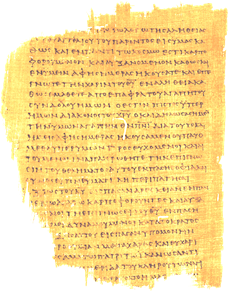“The city of Colossae in the Roman province of Asia was located primarily on the south bank of the Lycus River inside the Lycus Valley, near the foot of Mount Cadmus, southeast of Hierapolis and east/southeast of Laodicea. In the 1st century, it seems that Colossae was a ‘town’ not as large or important as the nearby ‘city’ of Laodicea to which Colossae was contrasted. The fields around Colossae yielded produce such as olives and figs, and the many sheep pastured in the area contributed to a wool industry which included the production of a popular wool dyed dark red/purple. In the 1st century AD, Pliny wrote about the purple wool of Colossae’s fame, made with a dye from the cyclamen flower (left); the Latin word ‘collossinus’ (purple wool) seems to be derived from the name of the city.”
“Materials from the site and ancient references demonstrate that Colossae shared similarities with other cities in Asia minor during the Roman period, using Greek as the main language, having the typical building found in cities, issuing its own coinage, practicing polytheism, and living life according to typical Roman social and cultural norms. The people had families, servants, understood Greek, used Roman money, worshiped various deities, and worked primarily in the agricultural sector.”
“Although Colossae was possibly the smallest of the three cities in the valley, the letter was sent to the church there because of the personal connections of Paul to Epaphras, Philemon, and Onesimus, and because Onesimus was returning to Philemon in Colossae with Tychius (Col 4:7-9; Phm 10). Both Philemon, who was a church leader and host, and Onesimus, were members of the church in Colossae (Phm 1-2; Col 4:9). It is also possible that there was a much larger Christian community in Colossae at that time, but by around 90 AD and the writing of Revelation it had shifted to the major urban center of Laodicea, perhaps as a result of the earthquake in the region. The church in Colossae and the Lycus Valley apparently was established while Paul was living in Ephesus around 55 AD (Acts 19:10). The Christian who brought the Gospel to Colossae and the surrounding area and continued to be a leader in the church, Epaphras, had a name which has been found on a few Roman period inscriptions and seems to be a shortened form of Epaphroditus (Col 1:7, 4:12; Phm 23; Php 2:25, 4:18). Interestingly, an inscription found at Colossae contains the name T. Asinius Epaphroditus, demonstrating the use of the name in the Roman period at Colossae. Unlike many of the cities in Asia minor, Paul [indirectly brought] the Gospel to Colossae (Acts 19:10), and he may never have even visited the city (Col 2:1, 4:12-17). When Paul wrote to the Colossians, he was imprisoned (Acts 28:30-31).”
 “Paul’s letter to Colossae … demonstrates that Christianity had spread to the Lycus Valley by the middle of the 1st century AD. Papyrus 46 (right), from 200 AD or earlier and found in distant Egypt, is a copy of Colossians that has preserved almost the entire letter, indicating its antiquity and authenticity. The epistle warned against heresies of religious syncretism, or combining and replacing beliefs of Christianity with other religions or worldviews (Col 2:8-23). These problems with false teachers are understandable in light of the religious diversity of Colossae, which included Hellenistic and Roman religion and philosophy, Phrygian religion, and Judaism, and Paul actually mentions Greeks, Jews, barbarians, and Scythians in reference to those in the area of Colossae (Col 3:11). A Phrygian name, Apphia, … known from various inscriptions found in Phrygia, actually appears in a letter of Paul (Phm 2). Historical sources demonstrate that Jews had lived in the region of Phrygia from … about 200 BC; therefore, a considerable population of Jews, along with synagogues, would have been present in the area during the 1st century AD. The presence of multiple ethnic groups and religions at Colossae as described by Paul is also attested from several other sources.”
“Paul’s letter to Colossae … demonstrates that Christianity had spread to the Lycus Valley by the middle of the 1st century AD. Papyrus 46 (right), from 200 AD or earlier and found in distant Egypt, is a copy of Colossians that has preserved almost the entire letter, indicating its antiquity and authenticity. The epistle warned against heresies of religious syncretism, or combining and replacing beliefs of Christianity with other religions or worldviews (Col 2:8-23). These problems with false teachers are understandable in light of the religious diversity of Colossae, which included Hellenistic and Roman religion and philosophy, Phrygian religion, and Judaism, and Paul actually mentions Greeks, Jews, barbarians, and Scythians in reference to those in the area of Colossae (Col 3:11). A Phrygian name, Apphia, … known from various inscriptions found in Phrygia, actually appears in a letter of Paul (Phm 2). Historical sources demonstrate that Jews had lived in the region of Phrygia from … about 200 BC; therefore, a considerable population of Jews, along with synagogues, would have been present in the area during the 1st century AD. The presence of multiple ethnic groups and religions at Colossae as described by Paul is also attested from several other sources.”
Dr. Titus Kennedy is a field archaeologist working primarily with sites and materials related to the Bible. He works with ColdWater Media and Drive Thru History® to maintain historical accuracy throughout their scripts and locations. Sources: https://drivethruhistory.com/colossae/ (excerpted); Photo of P46 (of Col 1:5-13) http://earlybible.com/manuscripts/p46-Col-2.html.
Like this? Consider sharing it to Facebook by clicking the linked icon below.
